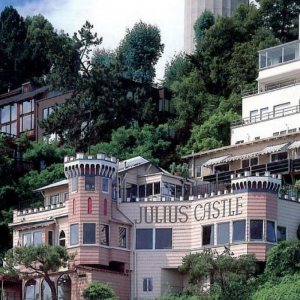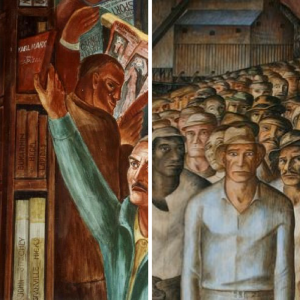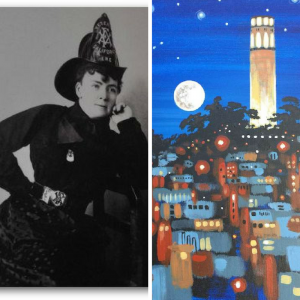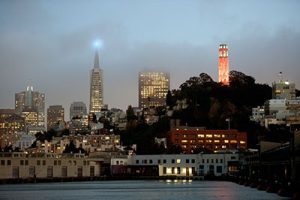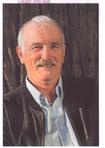John Michael McCarty's Blog, page 10
March 27, 2018
The Telegraph Hill Quarry
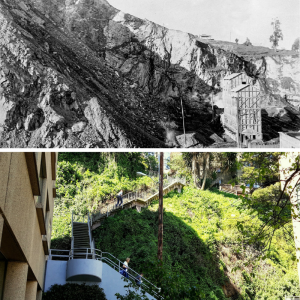 An initial blast of ninety dynamite kegs in 1867 sheared away the once gentle slope on the eastern side to form the Telegraph Hill Quarry. The main purpose of the site was to supply rocks to be used as ballast for the empty sailing ships leaving port. George and Harry Gray’s quarry continued for another thirty years until lawsuits and rioting locals shut down the operation.
An initial blast of ninety dynamite kegs in 1867 sheared away the once gentle slope on the eastern side to form the Telegraph Hill Quarry. The main purpose of the site was to supply rocks to be used as ballast for the empty sailing ships leaving port. George and Harry Gray’s quarry continued for another thirty years until lawsuits and rioting locals shut down the operation.
Following the 1906 earthquake, there was a need for new construction in its aftermath, including the building of a seawall on the Embarcadero. As the quarry encroached closer to housing, however, falling rocks injured children and adults, resulting in litigation and community protests. Soon thereafter, the company’s secretary was slain followed by George Gray himself.
Quarry:
The final blast at the quarry was timed to detonate in 1909 with the July 4th fireworks. The company continued for several years, concentrating their efforts at their Diamond Heights quarry where Harry Gray became a millionaire. Additional legal problems eventually caused the enterprise to shut down and declare bankruptcy. Almost one hundred years later in 2007, a massive slide on Telegraph Hill forced the evacuation of many residents. To the best of my knowledge, you can still descend Filbert Steps to the bottom of Telegraph Hill at Sansome Street.
For more photos and history of the district, scroll down and click on “Telegraph Hill”. For samples of our free monthly online magazine of old San Francisco and the Russian River, click on any of the dates below “Newsletter Archives”, also at the bottom of any page on the website. For a fun read of Telegraph Hill as well as the Russian River, check out Stumptown Daze, by going to “Novels”. Have fun exploring.
The post The Telegraph Hill Quarry appeared first on John McCarty.
March 26, 2018
Coyote of Telegraph Hill
A coyote of Telegraph Hill has taken up residence with the wild parrots in North Beach of San Francisco. There has been an increase in urbanized coyotes around the City in general, causing Animal Care & Control to put up warning signs on popular walking paths. The critters have shown they can survive in a surprisingly small territory such as the five-acre Pioneer Park, which surrounds Coit Tower at the top of Telegraph Hill. The sudden increase in coyotes likely started when they ventured across the Golden Gate Bridge from Marin County and began thriving in the Presidio before migrating south toward Golden Gate Park.
The Coyote of Telegraph Hill:
The coyote of Telegraph Hill possibly arrived there around 2005. It has become comfortable with humans, strutting around during daylight hours in an area ripe with foot traffic. Fruit trees, rodents and pet food have encouraged the animal to stick around. Besides the disappearance of a cat a few years ago, there haven’t been any reports of the Telegraph coyote acting aggressively. Hopefully, he doesn’t strap himself to a rocket and become airborne like his distant relative Wile E. Coyote.
For more photos and history of the district, scroll down and click on “Telegraph Hill”. For samples of our free monthly online magazine of old San Francisco and the Russian River, click on any of the dates below “Newsletter Archives”, also at the bottom of any page on the website. For a fun read of Telegraph Hill as well as the Russian River, check out Stumptown Daze, by going to “Novels”. Have fun exploring.
The post Coyote of Telegraph Hill appeared first on John McCarty.
March 24, 2018
The Steps of Telegraph Hill
If you’re seeking an adventure, explore the steps of Telegraph Hill. Once you’re at Coit Tower, find the path near the statue of Christopher Columbus and head down the Greenwich Steps where you’ll be wowed by the neighborhood forest and lush gardens. Along the way there are benches to take a break and absorb your surroundings. A fun flower to watch for is the Angel Trumpet as well as bee boxes, vegetable plots and some of the craziest rose bushes ever.
Continue your journey:
Make a right when you hit Montgomery Street to continue your journey. Soon you will spy one of the most beautiful Art Deco apartment buildings in the state. From here head down the boardwalk, known as Filbert Steps, and enjoy the architecture of this living, working community that seems frozen in time. The homes are built on the steep hillside and many have grand views of the bay. The cottage pictured above is currently for sale for $1.8 million, built in 1884. But buyer beware. There is no parking, which is why, perhaps, this gem has exchanged several hands over the years. Once you reach the bottom of the Filbert Steps, you can make a right to the Embarcadero, trolley line and Ferry Building. Make a left to Fisherman’s Whart and Pier 39. The trip is worth the effort.
For more, scroll to the bottom of this page and click on “Telegraph Hill”. Also, this area is featured in the novel Stumptown Daze, which is a romance comedy that has received favorable reviews from local newspapers and historical societies. Check it out by going to “Novels” above.
The post The Steps of Telegraph Hill appeared first on John McCarty.
March 21, 2018
Parrots of Telegraph Hill
The feral parrots of Telegraph Hill are 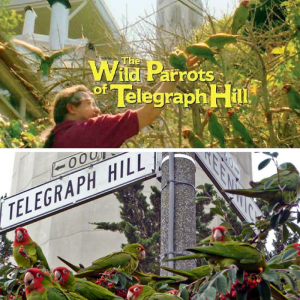 primarily red-masked parakeets, descended from escaped or released pets. The flock was popularized by a book and subsequent documentary (2003), both titled The Wild Parrots of Telegraph Hill.
primarily red-masked parakeets, descended from escaped or released pets. The flock was popularized by a book and subsequent documentary (2003), both titled The Wild Parrots of Telegraph Hill.
Filmed in 2005, the movie won 4 awards at different film festivals for best documentary. Through Mark Bittner’s own words, we learn of his life as a frustrated, homeless musician and how he came to live in the area where he decided to explore the nature around him. That lead him to discovering the parrot flock and the individual personalities of it. In a cinematic portrait, we are introduced to his colorful companions and the relationship they share as well as the realities of urban wild life that would change Bittner’s life forever.
Parrots:
The birds, known in the trade as cherry-headed conures, are native to Peru and Ecuador. They have established a breeding colony with the support of some residents and through the help of volunteers with Mickaboo Companion Bird Rescue. They range widely, including along The Embarcadero and in the Presidio. A controversial San Francisco city ordinance passed on June 5, 2007, prohibits the feeding of parrots in public spaces. The feeding ban was championed by Mark Bittne, the birds’ most outspoken supporter who fed them for years.
For more on Telegraph Hill, go to http://www.johnmccarty.org
The post Parrots of Telegraph Hill appeared first on John McCarty.
March 14, 2018
Julius’ Castle
Julius’ Castle, the historic San Francisco restaurant perched near the foot of Coit Tower, is still battling to reopen to diners. Although the Planning Commission has already recommended conditional use authorization to return the vacant city landmark to its roots as a restaurant, they issued a continuance last week, delaying their final approval until July 6, 2018.
A registered local landmark and among the city’s longest-running eating establishments, Julius’ Castle operated from 1922 until 2007, when its then property owner tried to rent it out as a non-restaurant space. No would-be royalty moved in, and current owner Paul Scott bought the property in 2012 to return it to its former use.
Julius’ Castle:
The present owner of Julius’ Castle wishes to retain the “old school” interior, which includes wood paneling purchased from the city’s 1915 Panama Pacific International Exposition. In addition, the view from 302 Greenwich Street has always been unique, luring such celebrities as Cary Grant, Marlon Brando, Robert Redford, Sean Connery and Ginger Rogers. But the king of the“castle” was longtime proprietor Julius Roz, an Italian immigrant restaurateur. According to a 1939 city guide, “To taste [Roz’s] fish sauce supreme, his tagliarini and his banana soufflé is to have a glimpse of an epicure’s heaven.” Today, however, some neighbors prefer the peace and quiet of life without the restaurant and are willing to bring their fight to City Hall.
For more on the area, go to http://www.johnmccarty.org and scroll down the page & click “Telegraph Hill”. You also may want to think about subscribing to Fellow Book Benders, a free online magazine loaded with historical tidbits and photos of old San Francisco and the Russian River. For samples, click on anyone of the dates under “Newsletter Archives”. Have fun exploring!
The post Julius’ Castle appeared first on John McCarty.
March 11, 2018
Coit Tower Murals
The Coit Tower murals were done under the auspices of the Public Works Art Project as part of F.D.R.’s New Deal to provide jobs for artists and help combat the 1930’s depression. The artworks depict the socialist views of the day. The photo on the left is a self-portrait of an artist reaching for a copy of Karl Marx’s Das Kapital. The photo on the right tries to illustrate racial equality among the working force. Other murals showcase the artists’ cynical view of city-life such as an auto-pedestrian accident (which looks fatal) while another mural portrays a man being robbed by a team of thugs amidst the hustle and bustle of urban life. The murals inside Coit Tower often paint workers in the heroic poses of socialist realism while well-dressed racially white members of the capitalist classes enjoy the fruits of their labor.
Murals:
John Langley Howard’s murals depict an ethnically diverse Labor March as well as showing a destitute family panning for gold while a wealthy ensemble observes. After a Diego Rivera mural was destroyed by Rockefeller Center patrons for the inclusion of an image of Lenin, San Francisco artists protested, picketing Coit Tower. This angered the conservative majority in the City and local government threatened to due away with the murals altogether. Fortunately this did not happen and the art works are available today without charge for public viewing . Viva la revolucion!
The post Coit Tower Murals appeared first on John McCarty.
March 9, 2018
Lillie Coit
Lillie Coit was one of the more eccentric characters in the history of Telegraph Hill, smoking cigars and wearing trousers long before it was socially acceptable for women to do so. She was an avid gambler and often dressed like a man in order to gain entrance into the highroller establishments that dotted North Beach. She loved to chase fires and on one incident at age fifteen, she threw her school texts down and ordered bystanders to pitch-in to put out a blaze. Knickerbocker Engine Co. No. 5 made her their official mascot, rendering her a perpetual Hall Pass to miss school when “duty” called. Her Last Will and Testament funded the monument following her death in 1929.
Coit Tower:
The intention of the Coit Tower design is still debated today. Many argue that it mirrors the image of a fire nozzle, but there are others who hold a much different opinion. Alfred Hitchcock insisted that Coit Tower be visible from his lead actor’s (played by Jimmy Stewart, co-starring Kim Novak) boudoir in the movie Vertigo. When asked why, the director simply said because “It’s a phallic symbol,” and he showed a rare grin. As a devout sinner, I prefer the later version. What’s your take on it? Next post, we’ll look at the murals inside Coit Tower.
The post Lillie Coit appeared first on John McCarty.
March 7, 2018
Telegraph Hill
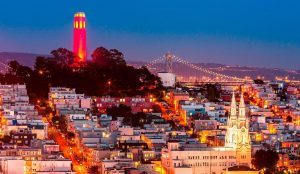
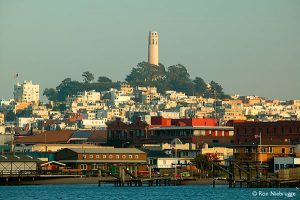 Telegraph Hill provides spectacular views in all directions. If you face the west, you can see Russian Hill, Marin County, the Golden Gate and its fantastic Pacific sunsets. Move to the north side to see Alcatraz, Angel Island and the bay, its waters changing in color and pattern with tidal currents and variations in the weather. A little further in the direction of the morning sun are the cities along the eastern shore, including Oakland.
Telegraph Hill provides spectacular views in all directions. If you face the west, you can see Russian Hill, Marin County, the Golden Gate and its fantastic Pacific sunsets. Move to the north side to see Alcatraz, Angel Island and the bay, its waters changing in color and pattern with tidal currents and variations in the weather. A little further in the direction of the morning sun are the cities along the eastern shore, including Oakland.
Views of Telegraph Hill:
Step around to the southern slop and the views of Telegraph Hill open up to the Financial District of the city with its myriad details from short and stubby boxes to the sixty-one stories at Salesforce Tower. Once the night takes over, the views become an intricate electrical playground. Even the locals like to play tourist once in a while and venture to Coit Tower and Pioneer park. To add a little adventure to your outing, hop aboard the No. 39 bus, which will take you to the summit. From there you can explore the steps that meander down the east side past multicolored houses (some dating back to 1880’s) and lush gardens. Happy hunting!
The post Telegraph Hill appeared first on John McCarty.
March 4, 2018
Telegraph Hill
Telegraph Hill is one of San Francisco’s forty-four substantial mounds. The many Irish immigrants who settled there formerly knew it as Goat Hill. Interesting enough, it soon became a burial ground for non-Catholic seamen. Hmmm (I’m not going there). The hill owes its name to a semaphore, which would signal the townspeople as to the nature of ships and their cargo coming through the Golden Gate. If a merchant didn’t have this advance knowledge, he might be hoodwinked into paying too high a price for his product.
Telegraph Hill:
Sailing ships brought cargo to San Francisco, but needed ballast when leaving. Rocks for this purpose were quarried from the bay-side of Telegraph Hill. During the gold rush days, it was difficult to provide a crew for exiting vessels. For a fee, bartenders would spike the drinks of unsuspecting souls and have them transported to a shack on the east side of Telegraph Hill where they would later be hauled down to the Embarcadero and shanghaied aboard an outgoing ship. A few of these “holding” pens still exist. Take a walk down the Filbert Steps and meander through history. It’s my favorite place in all of North Beach. What’s yours? http://www.johnmccarty.org
The post Telegraph Hill appeared first on John McCarty.
August 25, 2017
Communes of Sonoma County
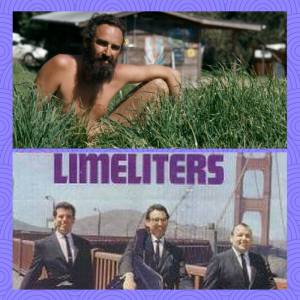
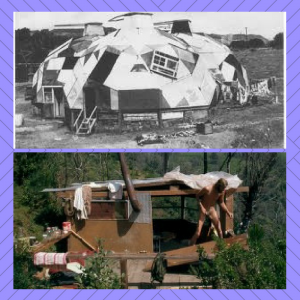
Morning Star Ranch, a.k.a. Morningstar Commune and The Diggers Farm, was a rural commune in west Sonoma County between the towns of Occidental and Sebastopol. Its founder was Lou Gottleib of The Limeliters music group. Tired of the corporate rat race, he “turned on, tuned in, and dropped out”. He coined the acronym LATWIDNO (Land Access To Which Is Denied No One). They preached that if you told no one to leave, that the land would select who should live on it.
The domiciles at Morning Star Ranch were of a wide variety of shapes and sizes, made of various materials ranging from reclaimed wood to canvas to plastic to glass. Each had its own unique personality and earthly appeal, reflecting that of its residents. Everything from a geodesic dome to a tree house could be found here.
Side Bars:
The Limeliters were an American folk music group formed in 1959 consisting of Lou Gottleib (bass violin/bass), Alex Hassiley (banjo/baritone), and Glenn Yarbrough (guitar/tenor). They disbanded in 1965 and reunited again in 1981, but the death of Lou Gottleib four years later was a great loss to the group. Glenn Yarbrough went on to become a successful solo artist until his demise last year.
They recorded over thirty albums with such hit singles as “The Midnight Special” and “A Hundred Men”. Their autobiographical son, “Acres of Limeliters”, noted the activity of the members while they had been apart including the line “…while Lou played Executive Hippie at his Morningstar groupie rest home.”
The phrase “Turn on, tune in, drop out” was the creation of Timothy Leary. He was a psychologist who conducted experiments with LSD while teaching at Harvard. He was fired for “failure to keep classroom appointments”. During the sixties and seventies, he was arrested often enough to see the inside of a prison on 36 different occasions. President Nixon once described him as “the most dangerous man in America”.
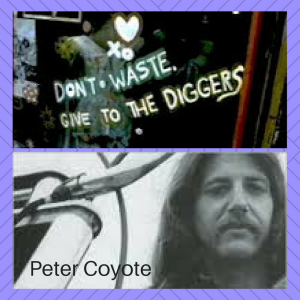
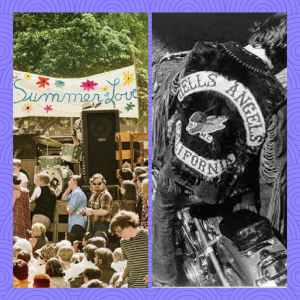
The Diggers were a radical community-activist group. They were anarchists with close ties to the guerrilla theater group known as the San Francisco Mime Troupe, which was headed up by Peter Coyote and managed by Bill Graham. The Diggers believed in a system of bartering where medical, clothing, food and music could be distributed freely. To help with the dispersal of these goods and services, the outfit relied on the cooperation of Sonny Barger and his Hells Angles.
With over a hundred thousand teens, vets, and whackos descending upon the Haight-Ashbury during the Summer of Love in 1967, much of the above goods were in short supply. To help alleviate this problem, Morning Star Ranch grew fruits and vegetables for the masses back in the City with the understanding that the Diggers would care for the crops at the commune.
Side Bars:
Peter Coyote starred in such films as Jagged Edge, Outrageous Fortune, Erin Brockovich, and A Walk to Remember. He has said that he is a Zen Buddhist first, an actor second.
Sonny Barger is the founder of the Oakland chapter of the Hells Angels. He became known as the “guardian angel” of the Haight Ashbury, helping with the transportation of food from Morningstar to San Francisco as well as providing free security for music concerts. Many believe this was a cover for his operation’s control of the LSD trade in the City.
Bill Graham held an arrangement with Morningstar for their Gravenstein apples. If he aided the Diggers with the maintenance of the orchard, he could have all the apples he wanted. The fruit had special meaning for him. It was the one thing that kept him alive as he fled from the Nazis in World War II as a ten-year-old. Apples were a standard giveaway at his Fillmore Auditorium concerts, a private tribute to his survival.
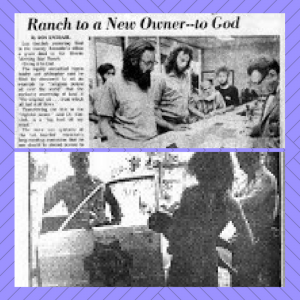
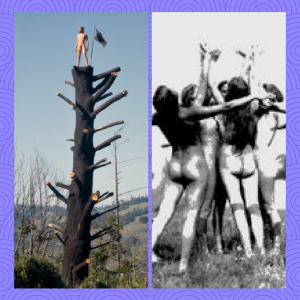
The thirty acre commune of Lou Gottleib drew young people who sought freedom from convention, government and parents. They wanted to “get back to the land” where they could escape the rigidity of mainstream America. Most sported full tans as clothing was optional. People gravitated into groups, which became “neighborhoods” with their own special flavor. There were families of few and many, singles and couples. All these could change in a heartbeat and often did.
The ranch existed in this state for a short time (1967-1972). In an attempt to ward off the many threats from his neighbors, Lou Gottleib willed his land to God. After all, who ever heard of God paying taxes? A series of court appeals culminated in the 9th District Court ruling that God had no property rights in the state of California. Sonoma County finally placed a permanent injunction, forbidding anyone but members of the Gottleib family from living at Morningstar.
Side Bars:
The county proceeded to bulldoze the structures at Morningstar on three different occasions all at Lou Gottleib’s expense. He was held in “contempt of court” for not telling the commune residents to leave, earning him $14,000 in fines as well as a week in jail.
Morning Star Ranch is currently up for sale by the Gottleib heirs. They are seeking someone who would like to purchase the land and donate the acreage to a local land trust.
Attributions & Asides:
A special thank you is due to anonymous subscribers for sharing their memories of Morning Star Ranch. Also, a note of appreciation goes to the following individuals and organizations: Marsee Henon, Friends of Rio Nido (http://rionido.net/history/postcards) Card Cow Vintage Postcards (https://www.cardcow.com), Sonoma County Historical Society, Russian River Historical Society, San Francisco Museum and Historical Society, and Wikipedia.
To subscribe a friend to this newsletter (Fellow Book Benders) or to discover more information regarding John McCarty’s novels, go to https://www.johnmccarty.org/
The post Communes of Sonoma County appeared first on John McCarty.



